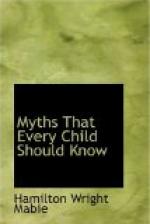And thus Mother Ceres went wandering about for nine long days and nights, finding no trace of Proserpina, unless it were now and then a withered flower; and these she picked up and put in her bosom, because she fancied that they might have fallen from her poor child’s hand. All day she travelled onward through the hot sun; and at night, again, the flame of the torch would redden and gleam along the pathway, and she continued her search by its light, without ever sitting down to rest.
On the tenth day, she chanced to espy the mouth of a cavern, within which (though it was bright noon everywhere else) there would have been only a dusky twilight; but it so happened that a torch was burning there. It flickered, and struggled with the duskiness, but could not half light up the gloomy cavern with all its melancholy glimmer. Ceres was resolved to leave no spot without a search; so she peeped into the entrance of the cave, and lighted it up a little more by holding her own torch before her. In so doing, she caught a glimpse of what seemed to be a woman, sitting on the brown leaves of the last autumn, a great heap of which had been swept into the cave by the wind. This woman (if woman it were) was by no means so beautiful as many of her sex; for her head, they tell me, was shaped very much like a dog’s, and, by way of ornament, she wore a wreath of snakes around it. But Mother Ceres, the moment she saw her, knew that this was an odd kind of a person, who put all her enjoyment in being miserable, and never would have a word to say to other people, unless they were as melancholy and wretched as she herself delighted to be.
“I am wretched enough now,” thought poor Ceres, “to talk with this melancholy Hecate, were she ten times sadder than ever she was yet.”
So she stepped into the cave, and sat down on the withered leaves by the dog-headed woman’s side. In all the world, since her daughter’s loss, she had found no other companion.
“O Hecate,” said she, “if ever you lose a daughter, you will know what sorrow is. Tell me, for pity’s sake, have you seen my poor child Proserpina pass by the mouth of your cavern?”
“No,” answered Hecate, in a cracked voice, and sighing betwixt every word or two—“no, Mother Ceres, I have seen nothing of your daughter. But my ears, you must know, are made in such a way that all cries of distress and affright, all over the world, are pretty sure to find their way to them; and nine days ago, as I sat in my cave, making myself very miserable, I heard the voice of a young girl shrieking as if in great distress. Something terrible has happened to the child, you may rest assured. As well as I could judge, a dragon, or some other cruel monster, was carrying her away.”




